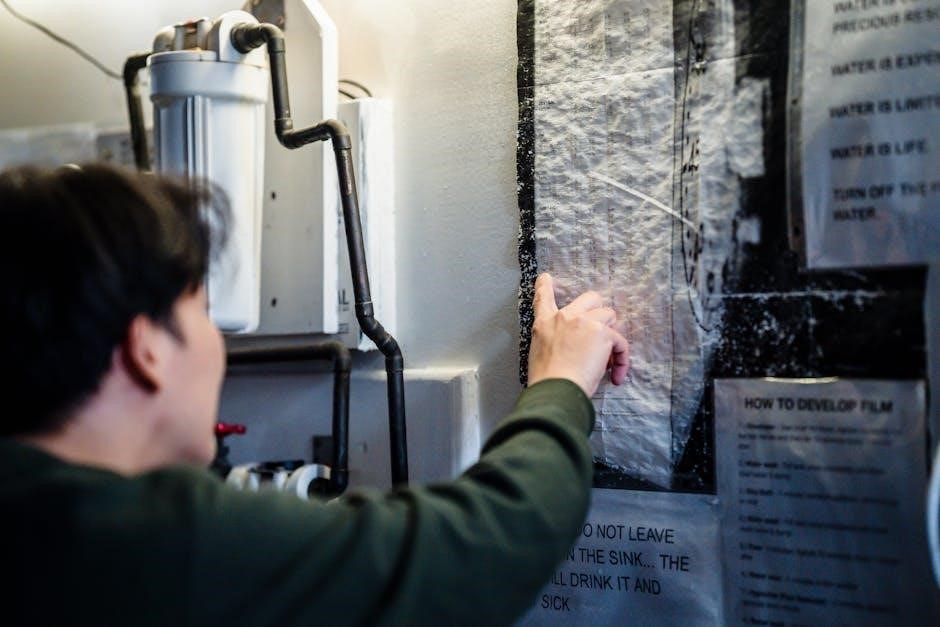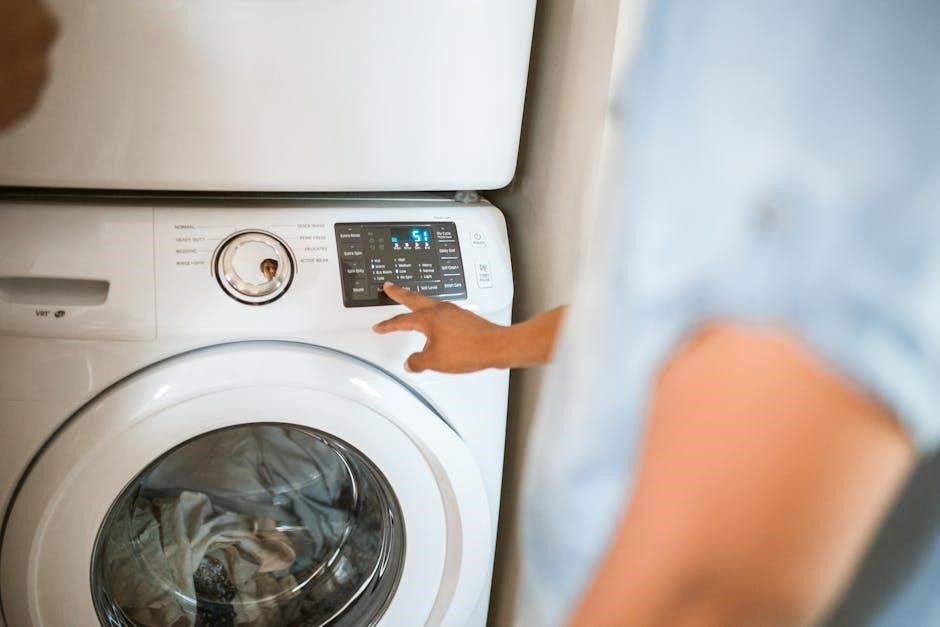
lifevac instructions
LifeVac is an innovative anti-choking device designed for emergency situations․ Easy to use‚ following instructions is crucial for proper safe and effective application to save lives․
1․1 What is LifeVac?
LifeVac is a non-invasive‚ portable anti-choking device designed to save lives in emergency situations; It works by creating suction to remove airway obstructions‚ making it an essential tool for first aid․ Unlike traditional methods‚ LifeVac does not require physical strength or complex techniques‚ making it accessible to anyone․ The device is accompanied by detailed instructions and training materials‚ including QR codes linking to video guides‚ ensuring proper usage․ Its simplicity and effectiveness have made it a trusted choice for choking emergencies‚ providing a reliable solution when every second counts․
1․2 Importance of Following LifeVac Instructions
Adhering to LifeVac instructions is critical for effective and safe use․ Improper application can lead to injury or fail to dislodge the obstruction‚ potentially resulting in severe consequences‚ including death․ The device’s design requires precise steps to ensure suction is applied correctly‚ and skipping or misperforming these steps can compromise its effectiveness․ Proper training and following the provided guidelines are essential to maximize success in emergency situations․ LifeVac’s instructions are backed by medical expertise‚ and deviations may reduce its reliability․ Always refer to the official manual or training materials to ensure correct usage and maintain the device’s life-saving potential․

Essential Components of LifeVac
LifeVac consists of a facemask‚ suction unit‚ and bellows․ These components work together to create powerful suction necessary for dislodging airway obstructions effectively in emergencies․
2․1 Overview of the LifeVac Device
LifeVac is a portable‚ non-invasive anti-choking device designed to save lives in emergency situations․ It consists of a facemask‚ a suction unit‚ and bellows‚ which work together to create powerful suction to dislodge airway blockages․ The device is FDA-registered and safe for use on adults‚ children‚ and infants․ Its compact design makes it easy to carry and use in various settings․ LifeVac requires no advanced training‚ though proper use is essential for effectiveness․ It includes a practice mask for familiarization and comes with a QR code linking to training videos․ Always store LifeVac in an accessible location for emergencies and ensure all components are intact before use․
2․2 Accessories Included with LifeVac
LifeVac comes with essential accessories to ensure effective and safe use․ These include multiple-sized masks to fit adults‚ children‚ and infants‚ ensuring a proper seal during emergencies․ A practice mask is also provided‚ allowing users to familiarize themselves with the device before an emergency occurs․ Additionally‚ the LifeVac suction unit is accompanied by a QR code that links to video training instructions‚ guiding users through proper usage․ The device is stored in a compact carrying case‚ maintaining organization and accessibility․ Instructions for use are included in a detailed booklet‚ and the suction unit is pre-assembled for immediate use․ These accessories collectively enhance readiness and effectiveness in choking emergencies․

Step-by-Step Instructions for Using LifeVac
LifeVac provides clear‚ easy-to-follow steps for effective use in choking emergencies․ Proper placement‚ compression‚ and swift action are key to safely dislodging an airway obstruction․
3․1 Placing the Mask Over the Victim’s Nose and Mouth
Proper placement of the LifeVac mask is essential for effective use․ Ensure the mask is centered and sealed snugly over the victim’s nose and mouth․ Hold the mask firmly‚ pulling the jaw upward to maintain an open airway․ A good seal is critical to create the necessary suction․ If the victim is unconscious‚ gently tilt their head back to open the airway further․ Proper alignment ensures the device works effectively to dislodge the obstruction․ Practice this step during training to build confidence and ensure quick‚ accurate placement in an emergency situation․
3․2 Attaching the Suction Unit to the Facemask
Once the mask is properly placed‚ attach the LifeVac suction unit by aligning it with the facemask․ Insert the mask into the unit with a firm twisting motion until it clicks securely into place․ Ensure the connection is tight to maintain a proper seal․ Double-check that the suction unit is fully engaged and the mask is not loose․ A secure attachment is critical for effective suction․ Follow the manufacturer’s instructions to avoid improper connection‚ which could reduce the device’s effectiveness․ Proper attachment ensures maximum suction power to help dislodge the obstruction safely and efficiently․
3․3 Compressing the Bellows
After securely attaching the suction unit to the facemask‚ locate the bellows on the LifeVac device․ To compress the bellows‚ firmly push the handle downwards with one hand until it reaches the fully compressed position․ Ensure the motion is smooth and deliberate to build up sufficient suction power․ It’s important to avoid partial compression‚ as this may reduce the effectiveness of the suction․ Proper compression ensures maximum vacuum pressure when the handle is pulled upward․ If the bellows are not fully compressed‚ the device may not dislodge the obstruction effectively․ Always follow the manufacturer’s instructions for correct technique to ensure safety and efficiency․
3․4 Pulling the Handle Upward
Once the bellows are fully compressed‚ grasp the handle firmly with both hands․ Pull the handle upward with a swift‚ steady motion to create a strong vacuum․ This action dislodges the object from the victim’s airway․ Ensure the movement is smooth and forceful to maximize suction power․ After pulling‚ release and check if the obstruction has been cleared․ If the object remains‚ repeat the process as needed‚ but always follow the manufacturer’s guidelines to avoid causing harm․ Proper execution of this step is critical for effective choking relief and victim safety․
3․5 Repeating the Process if Necessary
If the object is not dislodged after the first attempt‚ the process can be repeated by releasing the handle‚ allowing the bellows to return to their original position‚ and ensuring the mask remains securely in place․ Check the victim’s airway after each attempt to verify if the obstruction has been cleared․ Repeat the steps of compressing the bellows and pulling the handle upward as needed‚ up to a maximum of three attempts․ If the object remains lodged after three attempts‚ immediately seek professional medical assistance․ Always follow the manufacturer’s guidelines and ensure proper technique to avoid causing harm․ Proper repetition is key to effective choking relief․
Safety Considerations When Using LifeVac
Proper training‚ correct technique‚ and adherence to guidelines are essential to ensure safe and effective use of LifeVac‚ minimizing injury risks during emergencies․
4․1 Preparing the Victim for LifeVac Use
Preparing the victim is crucial for effective LifeVac use․ Ensure the victim is in an upright sitting or standing position to aid in dislodging the object․ If unconscious‚ lay them on their back․ Clear any visible obstructions from the mouth and ensure the airway is accessible․ Properly position the mask over the nose and mouth‚ ensuring a tight seal for effective suction․ For infants‚ use the smallest mask size provided․ Always adhere to the manufacturer’s guidelines for sizing and placement․ If the victim is unresponsive‚ begin CPR if trained‚ and use LifeVac as needed․ Never delay seeking professional medical help after the obstruction is cleared․
4․2 Preventing Injury During the Procedure
Preventing injury during LifeVac use requires careful adherence to the instructions․ Ensure the mask is correctly placed over the nose and mouth‚ avoiding any unnecessary force that could cause harm․ Proper training is essential to handle the device safely and effectively․ Avoid using excessive force when compressing the bellows or pulling the handle upward‚ as this could potentially injure the victim․ Always follow the manufacturer’s guidelines to minimize the risk of injury․ If the victim is unconscious‚ take care to maintain their airway and avoid improper positioning․ Proper technique‚ as demonstrated in training materials‚ is key to preventing injury and ensuring the procedure is performed safely․
Training and Practice with LifeVac
LifeVac training is essential for proper use․ QR codes provide video guides‚ and regular practice ensures familiarity and confidence in emergency situations․
5․1 Sources of LifeVac Training Materials
LifeVac training materials are readily available to ensure users are well-prepared․ Each device includes a detailed instruction booklet and a QR code linking to video guides․ These videos‚ powered by EKYZ LifeVac Training‚ provide step-by-step demonstrations for proper use․ Additional resources‚ such as practice masks‚ allow users to familiarize themselves with the device before emergencies․ The official LifeVac website also offers downloadable materials and certification programs․ Regular training sessions‚ led by certified instructors like Ryan Sharman‚ further enhance user confidence and competence․ These comprehensive resources ensure that anyone can learn to use LifeVac effectively‚ making it a reliable choice for choking emergencies․
5․2 Importance of Practicing with LifeVac
Practicing with LifeVac is crucial for effective and safe use in emergencies․ The device comes with a practice mask‚ allowing users to familiarize themselves with its operation․ Regular practice ensures proper technique‚ such as securing the mask and compressing the bellows correctly․ Training videos‚ accessible via QR codes‚ provide visual guidance to reinforce instructions․ Improper use can lead to injury or fail to dislodge the object‚ making practice essential․ By practicing‚ users gain confidence and the ability to act quickly in high-stress situations․ This preparation is vital for maximizing the device’s effectiveness and ensuring successful outcomes during choking emergencies․

Comparison of LifeVac with Other Anti-Choking Methods
LifeVac stands out as a non-invasive‚ easy-to-use alternative to methods like the Heimlich maneuver․ Its design ensures effectiveness without physical contact‚ making it ideal for untrained individuals in emergencies․
6․1 LifeVac vs․ Heimlich Maneuver
LifeVac offers a non-invasive alternative to the Heimlich maneuver‚ eliminating the need for physical contact or abdominal thrusts․ Unlike the Heimlich‚ which requires strength and proper technique‚ LifeVac relies on suction to dislodge obstructions․ This makes it easier for untrained individuals to use effectively in emergencies․ The Heimlich maneuver can sometimes cause injury if performed incorrectly‚ while LifeVac’s design minimizes such risks․ Both methods aim to clear airway blockages‚ but LifeVac’s simplicity and safety features make it a preferred choice for many․ Proper training and adherence to instructions are crucial for the safe and effective use of either method․

Maintenance and Storage of LifeVac
Store LifeVac in a cool‚ dry place‚ away from direct sunlight․ Regularly inspect for damage and ensure all parts are clean․ Check expiration dates on masks and the device itself for optimal functionality․ Proper storage and maintenance ensure readiness in emergency situations․
7․1 Proper Storage Conditions for LifeVac
LifeVac should be stored in a cool‚ dry place away from direct sunlight and moisture․ Avoid extreme temperatures or environments that may damage the device․ Ensure the unit is clean and free from debris․ Store the LifeVac in its original packaging or a protective case to prevent accidental damage․ Regularly inspect the device for any signs of wear or tear‚ and replace any damaged parts immediately․ Always check the expiration dates on the masks and the device itself to ensure reliability․ Proper storage conditions help maintain the device’s effectiveness and readiness for emergency situations․ Follow the manufacturer’s guidelines for optimal preservation․
Troubleshooting Common Issues with LifeVac
Common issues include improper mask placement or failure to create a proper seal․ Ensure correct positioning and check for blockages to maintain suction effectiveness during use․
8․1 What to Do If LifeVac Fails to Dislodge the Object
If LifeVac fails to dislodge the object‚ ensure the mask is properly sealed over the victim’s nose and mouth․ Reposition the device if necessary and repeat the process․ If unsuccessful‚ do not delay seeking professional medical help immediately․ Persistent blockages require advanced intervention․ Always follow the manufacturer’s instructions and seek training to improve effectiveness․ Proper technique is critical to avoid complications․ If the object remains lodged‚ call emergency services without delay․ LifeVac is a valuable tool‚ but it is not a substitute for professional medical care in severe cases; Ensure the victim’s airway remains a priority and act swiftly to prevent further harm․

Case Studies and Success Stories
LifeVac has saved numerous lives in choking emergencies‚ with real-life examples showcasing its effectiveness in dislodging objects and restoring breathing․ Its success stories highlight its reliability and life-saving potential․
9․1 Real-Life Examples of LifeVac Saving Lives
LifeVac has proven its effectiveness in numerous real-life emergencies․ For instance‚ a child choking on a grape was saved when LifeVac successfully dislodged the object․ Similarly‚ an elderly individual with a blocked airway was rescued after a caregiver used the device correctly․ These cases demonstrate how LifeVac’s simple design and proper usage can restore breathing quickly․ Many users have shared stories of how LifeVac saved lives during choking incidents‚ highlighting its reliability and ease of use․ Such examples underscore the importance of having LifeVac accessible in emergency situations and being trained in its proper application․

Legal and Regulatory Information
LifeVac complies with FDA and international medical device regulations‚ ensuring safety and efficacy․ Proper use as per instructions is legally required to avoid liability and ensure effectiveness․
10․1 Compliance with Medical Device Regulations
LifeVac adheres to strict medical device regulations‚ including FDA and international standards‚ ensuring its safety and efficacy․ The device undergoes rigorous testing and quality control to meet compliance requirements․ Manufactured with precision‚ LifeVac is designed to deliver reliable performance in emergency situations․ Proper use‚ as outlined in the instructions‚ is essential to maintain compliance and ensure the device functions effectively․ Users must adhere to guidelines to avoid legal liability and guarantee the product’s intended purpose․ LifeVac’s compliance with regulations is verified through certifications and regular audits‚ reinforcing its trustworthiness as a medical device․ Always check the expiry date and storage conditions to maintain compliance and safety․

User Reviews and Feedback
Users praise LifeVac for its ease of use and effectiveness in emergencies․ Many testimonials highlight its ability to save lives‚ earning trust as a reliable solution․
11․1 What Users Are Saying About LifeVac
Users consistently praise LifeVac for its effectiveness and ease of use in emergency situations․ Many highlight its ability to save lives‚ with testimonials often expressing gratitude for its reliability․ Parents and healthcare professionals particularly appreciate its simplicity and success rate․ A common sentiment is that LifeVac provides peace of mind‚ knowing a solution is available for choking emergencies․ Reviews frequently mention how the device has become a must-have in households and workplaces․ Overall‚ the feedback underscores LifeVac’s role as a trusted and vital tool for preventing choking-related tragedies․

Emergency Preparation Tips
Always keep LifeVac accessible in easy-to-reach locations․ Regularly check the device for expiration dates and proper function to ensure readiness during emergencies․
12․1 Keeping LifeVac Accessible in Emergency Situations
To ensure quick access during choking emergencies‚ store LifeVac in visible‚ easy-to-reach locations such as kitchens‚ dining areas‚ or near first aid kits․ Check expiration dates regularly and replace as needed․ Familiarize household members with the device’s location and basic operation․ Consider placing LifeVac in multiple strategic spots‚ especially in homes with young children or elderly individuals‚ to maximize availability․ Always keep the instruction booklet nearby for rapid reference․ Regularly inspect the device for damage or wear to ensure it is ready for use․ Accessibility and preparedness are key to saving lives during critical moments․

The Future of Choking Rescue Technology
Advancements in anti-choking devices like LifeVac are expected to enhance safety‚ accessibility‚ and effectiveness․ Innovations may include improved suction power‚ compact designs‚ and integrated training features for emergency preparedness․
13․1 Advances in Anti-Choking Devices
Future advancements in anti-choking devices like LifeVac may include enhanced suction technology‚ portable designs‚ and integrated sensors for real-time feedback․ Innovations could also focus on improving accessibility‚ with smaller‚ lightweight models and universal sizing․ Training advancements‚ such as augmented reality simulations‚ may become standard․ Manufacturers are likely to prioritize affordability and global distribution to ensure widespread availability․ These developments aim to make anti-choking devices more effective‚ user-friendly‚ and accessible to everyone‚ reducing choking-related emergencies worldwide․ Continuous research and collaboration with medical experts will drive these innovations‚ ensuring LifeVac remains a leader in choking rescue technology․
LifeVac is a crucial tool for saving lives in choking emergencies․ Following instructions ensures effectiveness․ Regular training and accessibility are key for emergency preparedness with LifeVac․
14․1 Final Thoughts on LifeVac Instructions
LifeVac is a reliable‚ easy-to-use device for choking emergencies․ Following the instructions carefully ensures effective use․ Training materials‚ including videos‚ are readily available to guide users․ Practicing the steps enhances confidence and preparedness․ The device’s simplicity and safety make it accessible to everyone․ Proper storage and maintenance are crucial for longevity․ Real-life success stories highlight its importance in saving lives․ Always prioritize correct usage to avoid complications․ LifeVac stands out as a vital tool in emergency situations‚ emphasizing the need for awareness and readiness․ By adhering to the guidelines‚ users can maximize its effectiveness and potentially save lives during critical moments․